Acer Aspire TimelineU M3: Life on the Kepler Verge
by Dustin Sklavos on March 13, 2012 5:56 PM ESTBattery Life
Getting detailed specifications for the Acer TimelineU M3 has been a little bit difficult; the notebook isn't on Acer's site yet (despite apparently having been released into the wild) and our reviewer's guide is a bit light on details. The box for it claims a meager 3-cell battery, but we're told it has a healthy 55Wh of capacity. That seems pretty dense, but as you'll see it's believable.
Unfortunately due to the crunch we don't yet have results for media playback, but those will be added as soon as humanly possible.
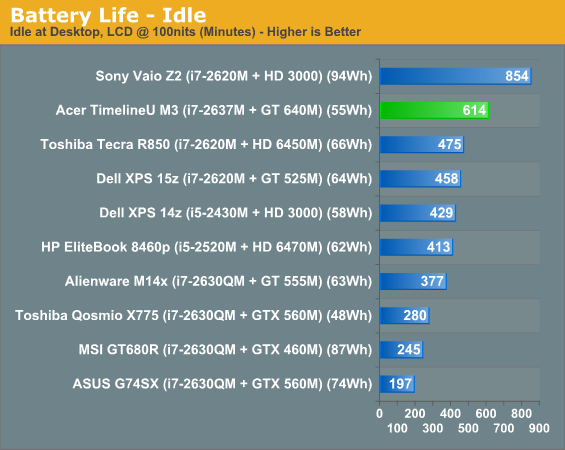
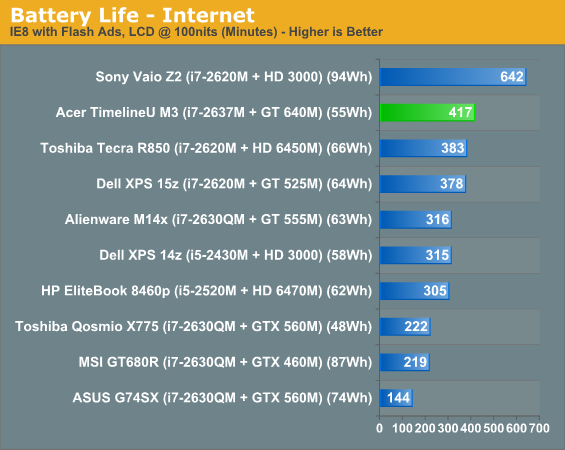
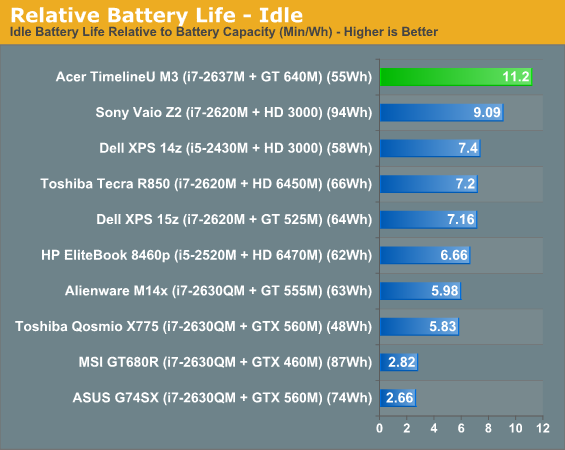
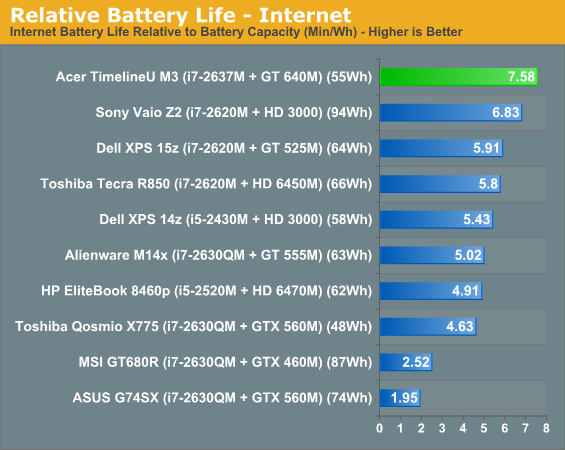
The TimelineU M3 absolutely rocks socks on the battery. NVIDIA's Optimus technology is in full effect here, and as a result the M3 is able to meet and beat the advertised eight hours of battery life that even the reviewer's guide for the M3 claims. This is one place where using the ULV i7-2637M does seem to pay major dividends compared to the full voltage chips.
Heat and Noise
Heat and noise are two more places where having that ULV chip seems to help the M3. While load noise isn't exactly ideal, it's only roughly 41dBA under load, and that's only when the GPU is being stressed. Meanwhile, no hot spots seem to develop on the top surface of the notebook. That said, top-center on the bottom of the M3 does get a bit warm; it's not uncomfortably hot and certainly won't scald you, but there's definitely a single sharp source of heat inside the M3.
Screen Quality
At the risk of digressing, when I used to write for NotebookReview I found myself trying to eschew talking about the speakers of the notebooks I reviewed whenever possible because the results were the same 99% of the time. That's remained true here; notebook speakers are typically only worth talking about when they're not terrible. The reason I bring this up is because I'm beginning to feel the same way when testing the notebook screens. It's obviously useful information, but this is a component that almost always underwhelms, and the same is true again with the Acer TimelineU M3.
While the 1366x768 resolution of today's mediocre TN panel is ideal for our bandwidth-constrained GPU, it doesn't require any feat of prestidigitation to say that the comments on this review will once again light up with well-founded complaints about a 15.6" screen running this resolution natively. Frankly it's just inadequate for a notebook this size, and we're going to keep harping about these subpar panels until manufacturers wise up and start getting it right.

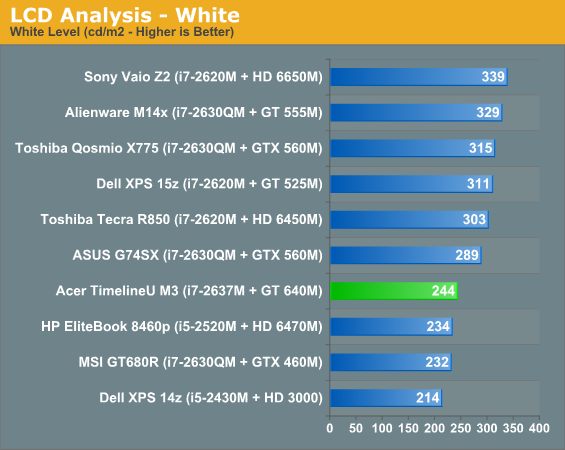

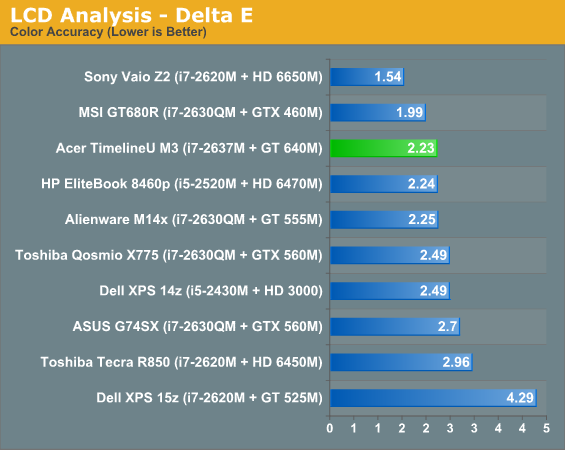
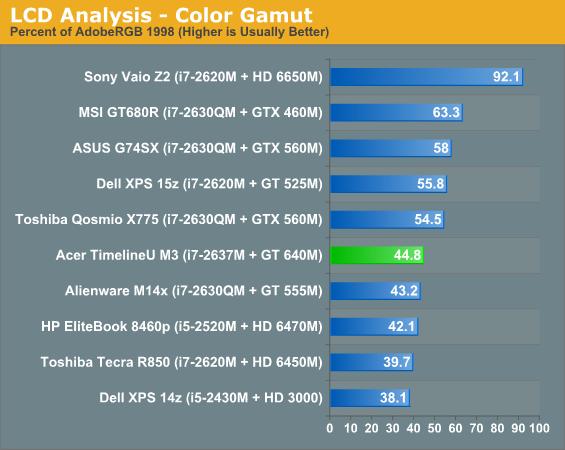
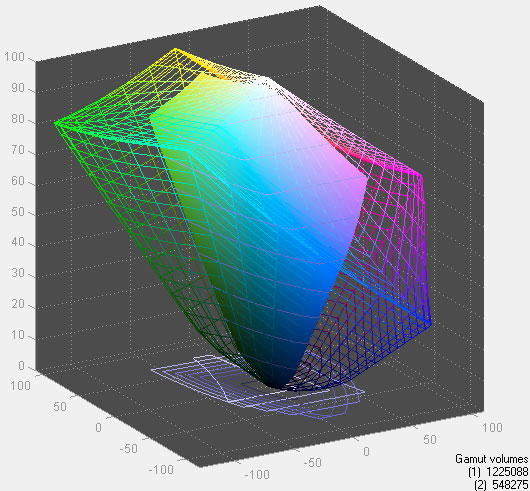
You can see from our test results that it doesn't necessarily have to be this bad. While the M14x's screen is underwhelming in places, it also runs at a superior 1600x900 resolution. The Sony Vaio Z2 may be a premium notebook (or at least a premium-priced one), but you at least see where some of that purchase price is going: a fantastic, high-resolution screen.
Meanwhile, the Acer TimelineU M3 sports the industry-standard dismal TN panel with weak viewing angles, low contrast, and low color accuracy and quality. This needs to change, and there's really no reason to settle for a crappy display when you're putting in 256GB SSDs.
And let's be clear about the costs: when an end user can go out and purchase a replacement AU Optronics B156HW01 v4 display for under $100 (compared to around $60 for a typical 1366x768 panel), the cost savings can't be that much for the laptop makers. Granted, with ultrabooks the manufacturers are also looking to get the thinnest panels they can find (another misguided goal in my book: thinness while sacrificing keyboard and display quality just doesn't make sense), but there are still much better 15.6" displays out there that would only increase the BOM by $50 at most.


_thumb.jpg)
_thumb.jpg)
_thumb.jpg)
_thumb.jpg)
_thumb.jpg)








76 Comments
View All Comments
tipoo - Wednesday, March 14, 2012 - link
It has 192, yeah. Interesting. But its in the same thermal envelope so who cares how many shaders there are, maybe they went AMDs route with less powerful individually but more numerous shaders.extide - Wednesday, March 14, 2012 - link
It pretty clear that the CUDA cores in kepler cannot be directly compared to the ones in past generations.With the full GK104 being rumored to have 1536 yet nowhere near 3x as fast as a GTX580 (512 CUDA cores), plus this card with 384 and significantly less performance than the 192 based fermi card.
MarsMSJ - Wednesday, March 14, 2012 - link
The mention of the 6650M in the Sony notebook should warrant an asterisk on all the GPU performance graphs. In those graphs there is nothing to differentiate or tell a reader that a built in 6650M will perform much better than a 6650M. We all know those graphs will be referenced and they imply that 6650M in a standard or non standard implementation will work
I can see clearly why NVidia likes your graphs because they're misleading.
mamisano - Wednesday, March 14, 2012 - link
I totally agree and glad that someone else feels the same way as me.JarredWalton - Wednesday, March 14, 2012 - link
The text has an explanation for the poor performance of the 6650M, and actually I have a 6630M review coming shortly where it outperforms the 6650M results, but there's still a large gap between it and the GT 640M.The bigger issue is that AMD doesn't have a lot of compelling laptops using their GPUs, and even the ones that do go with AMD have other quirks. The Z2 has it in an external dock where performance (at least on the internal laptop display) is hindered by Thunderbolt bandwidth; the VAIO SE16 (which I'm reviewing right now) has the 6630M, but the manually switchable graphics and almost complete lack of driver updates is going to make it a tough sell for gamers. HP's Envy has the same problem with driver updates.
We've heard from AMD that they'll be rolling out a "unified driver" for all their switchable graphics laptops, but until (if) that happens you're basically asking for problems down the road. Optimus may not be perfect, but compared to the AMD alternative it sure feels like it. :-(
MarsMSJ - Wednesday, March 14, 2012 - link
I understand what you're saying about your options. However, that still doesn't address the fact that your graphs do not express this is an exotic GPU implementation with additional contraints that are not normal, driver quirks or not. Keep mind you have lots of graphs and a very important bit of information hidden half way between them.You're not new to the internet, you know the nature and power of these graphs and their interpretation on the web. I'm not surprised in the least bit NVidia loves your graphs and testing.
Anyway.... any indication about the heat from this NVidia mobile GPU being common thing with upcoming products? :)
Hulk - Wednesday, March 14, 2012 - link
with the Super PLS screen.Help us Dustin Sklavos Kenobi, you're our only hope!
kenyee - Wednesday, March 14, 2012 - link
They should have stuck at least a 1080p screen on it and 4 memory slots so you can stuff 16GB of memory in it :-PI'm hoping the Macbook Air shows them how it's done too...and I hate rooting for Apple :-P
Sony's Z2 looks great, but has the same memory limitations, and no Kepler GPU :-(
trajan2448 - Wednesday, March 14, 2012 - link
I travel quite a bit and I always watch movies with my laptop. I hope they keep the DVD drive until there is some equivalent no hassle solution.noeldillabough - Wednesday, March 14, 2012 - link
Honestly say I haven't used an optical drive on laptops for years. Rip the movies to DivX or XVid and watch em on whatever device you like.